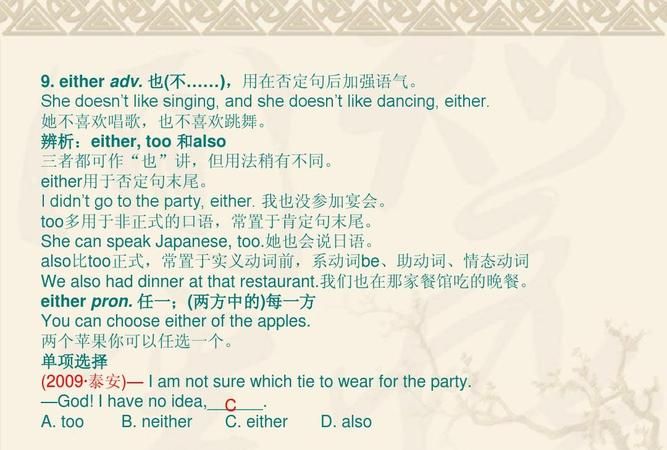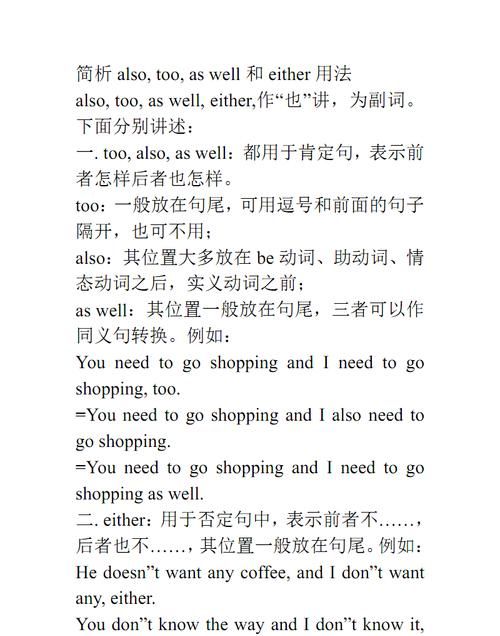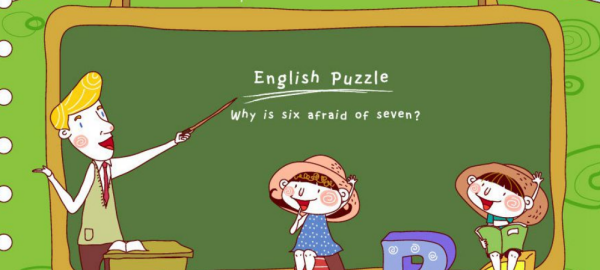本文目录
either和too的用法和区别
either,too,also的用法区别是:
一、含义不同
1、either:adv、也(用于否定句中)。
例句:She had met both sons and did not care for either。
两个儿子她都见了,一个都不喜欢。
2、also:adv、而且。
例句:She not only wrote the text but also selected the illustrations。
她不仅写了正文部分,而且还挑选了插图。
3、too:adv、也,太,而且,很。
例句:The salads taste too vinegary。
这色拉的味道太酸了。
二、用法不同
1、either:它用于否定句中,而且要放在句末。
例句:He seems either to fear women or to sentimentalize them。
他似乎要么怕女人要么就对她们怀有浪漫想法。
2、also:是比too较为正式的用语,通常用于肯定句中,一般靠近动词。
例句:Not only does she speak Spanish,she's also good with computers。
她不仅会说西班牙语,还精通计算机。
3、too:too通常放有句末,但有时为了不致引起含糊不清的感觉,把它紧放在所修饰的词之后。它也通常用于肯定句中。
例句:Guys can be codependent,too。
男人们也可能是依赖助成者。

三、使用场合不同
1、either:either用作副词时须放在否定的动词或形容词之后,表示“也(不)”,加强语气。
例句:On either side of the tracks the ground fell away sharply。
跑道两侧都是很陡的斜坡。
2、also:also主要用于肯定句和疑问句。在书面语中,also偶可用在no,nothing或其他带有否定意义的词之前,而在否定词之后则不能用also,而要用either。
例句:I went to New York last year,and I also spent some time in Washington。
我去年去了纽约,还在华盛顿待了些时间。
3、too:用于肯定句。too通常位于句末,其前的逗号可有可无,在书面语中,可位于句中,这时其前后一般应有逗号,在美式英语里,too可用于句首,其后必须有逗号。
例句:It's too tight across the back。
背部太紧。


too和either的区别
1、词性不同:
too是副词。
either是连词、副词、限定词、形容词。
2、单词发音不同:
too的发音:英[tuː]美[tuː]。
either的发音:英[ˈaɪðə(r); ˈiːðə(r)]美['iðər]。
3、意思不同:
too作副词时意为“太;也;很;还;非常;过度”。
either作连词时意为“或者,要么”,作副词时意为“也;而且”,作限定词时意为“(两者之中的)任何一个;作形容词时意为“(两者中) 任一的;两者择一的”。

扩展资料:
短语搭配:
1、not either 不可以 ; 也不是 ; 不是非此即彼 ; 不是。
2、either symbol 任一符号 ; 抉择符号 ; 翻译。
3、dunno either 不知道或者 ; 也不知道。
4、either at 在任一 ; 正在翻译。
5、Too late 来不及 ; 时已晚 ; 太迟。
6、too much 太多 ; 爱得过火 ; 太多了。
7、Too Human 无间战神 ; 非凡战士 ; 救世魔神 ; 中文版。
8、Too fast 太快 ; 太快了 ; 语速太快 ; 匆匆。
参考资料来源:百度百科-either
参考资料来源:百度百科-too
以上就是关于句末用too还是either ,either和too的用法和区别的全部内容,以及句末用too还是either 的相关内容,希望能够帮到您。
